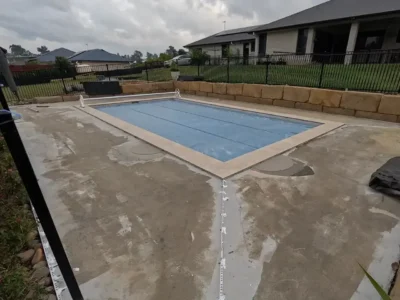Creating the perfect backyard pool area is the dream of many homeowners, and for good reason. But before you can relax and enjoy your brand new pool, there are many choices to be made regarding the style and design of your pool and the materials to be used. One of the biggest choices to be made is the selection of material for the pool deck and surrounds, as this can significantly impact both the look and feel of the pool, as well as its safety and usability. There are many surfacing choices available, and it can be confusing trying to choose which one will be best for your pool area. So, let’s have a look at some common pool surrounds materials and their benefits and drawbacks, to help you make the best choice.
Concrete
What it is:
Poured concrete is an easy way to surface your pool surrounds, and is a popular choice for public swimming pools.
Benefits:
- Long lasting and durable
- Low maintenance
- Cheaper than many other materials
- Is resistant to pool chemicals
- Provides a solid, uniform surface
Drawbacks:
- Can crack over time due to temperature changes and ground movement
- Cracks are very difficult to repair without repouring the entire area
- Can be slippery when wet
- Is not the most aesthetically appealing surface material
- Is unforgiving for falls and slips
- Retains heat, making it uncomfortable to walk on
Concrete pavers
What it is:
Concrete pavers are made from concrete and are designed to mimic the appearance of natural stone, but at a significantly lower cost.
Benefits:
- Are versatile and practical
- Are available in a wide range of shapes, sizes and colours
- Are sturdy and resistant to weathering
- Are cooler underfoot than stone
Drawbacks:
- Require proper installation to prevent shifting or settling and take longer to install
- Require sealing before use
- Are hard to replace or repair if damage occurs
- Can come with variations between batches, meaning your area will not look uniform
- Require regular applications of jointing sand
- Can be prone to weeds growing between the pavers
Stone
What it is:
Natural stone provides a timeless and elegant look around pools, and comes in a wide variety of options, including sandstone, travertine, bluestone, limestone and granite.
Benefits:
- Non-slip
- Looks very natural and aesthetically pleasing
- Is heat resistant and can withstand climate variations
- Is durable and resistant to wear
Drawbacks:
- Has high maintenance requirements
- Can show marks and stains over time
- Will need to be regularly cleaned, especially if located under trees that drop leaves and sap, or in shaded areas where moss and algae will grow
- Can be hot underfoot to walk on
- Requires sealing before use
- Can be slippery, which has the potential to cause trips and falls when wet
- Limited colour choices
- Is one of the most expensive pool surrounds materials
- Is hard to replace or repair if damage occurs
Timber
What it is:
Timber pool surrounds tend to look classic and appealing due to the warm, natural look of timber.
Benefits:
- Visually appealing
- Is more forgiving in the event of a fall
Drawbacks:
- Timber decks can get very hot in summer, and are uncomfortable to walk on barefoot
- Timber is highly susceptible to termite damage
- Requires frequent sealing to prevent damage from moisture, such as cracking, warping and rot
- Is slippery when wet
- Is high maintenance
- Is expensive
Brick
What it is:
Bricks offer a classic look around pools, but are not typically used in modern Australian pool design.
Benefits:
- Available in various colours
- Can create various patterns in your paving design
- Are resistant to fading and weathering
Drawbacks:
- Are slippery when wet
- Are a hard and unforgiving surface to fall or trip on
- Requires sealing before use
- Can look a little utilitarian around pools
Porous paving
What it is:
Porous paving is a type of permeable pavement that allows water to drain through the surface, and is a more modern and eco-conscious type of surfacing material.
Benefits:
- Provides excellent water drainage
- Chlorine and saltwater resistant
- Environmentally friendly, as it allows water to seep into the ground, rather than being washed off impermeable pavement surfaces like concrete or pavers
- Long lasting and durable
- The safest surface around due to its non-slip properties
- Cool underfoot and pleasant to walk on
- Looks natural and aesthetically pleasing
- Low maintenance
- Stain-resistant
- Is available in a variety of colours, styles, cuts and blends to suit your décor
- Is very cost-effective
- Is crack-resistant, as small air pockets within the paving allow it to expand and contract naturally
Drawbacks:
- Can occasionally become blocked with sediment which will need to be flushed through the pavement
Your choice of pool surrounds surface material should not only make your pool area look aesthetically pleasing, it also needs to make it durable and safe. When you consider all the features of common pool surrounds materials, there’s one that stands out for its high ratio of benefits to drawbacks – and that’s porous paving. Traditional pool surrounds materials aren’t specifically designed to work well around pools and wet surfaces, and their use can cause safety hazards, maintenance problems and discomfort (particularly in the hot and steamy Brisbane climate). Porous paving does away with all the problems of traditional materials, by providing a safe, comfortable and slip-free surface to walk on, that’s also durable, long-lasting and low maintenance. And it won’t cost you the earth either – in fact, the use of porous paving will actually help save the earth due to its strong environmental benefits. When it comes to safety, visual appeal, durability, budget and eco-friendliness, you simply can’t go past porous paving. Have a more in-depth look at porous pool surrounds here.



 Make your pool environmentally friendly – here’s how
Make your pool environmentally friendly – here’s how